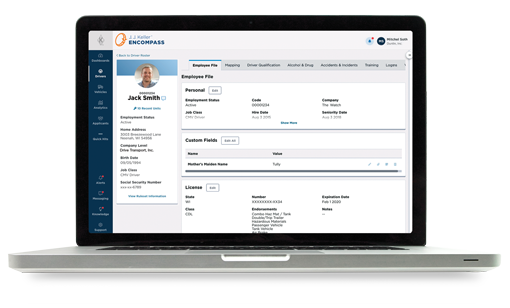Transport Safety Editor — J. J. Keller & Associates, Inc.
5 FAQs on DOT Drug & Alcohol Programs
Questions abound when it comes to the requirements of a DOT Drug & Alcohol program.
Published On: 03/29/2019


Written by:
Kathy Close
Questions abound when it comes to the requirements of a DOT Drug & Alcohol program. It’s only natural. Imagine the damage an impaired driver could cause behind the wheel of one of your commercial motor vehicles (CMVs). Beyond potentially fatal consequences, such reckless behavior could lead to a lawsuit, DOT investigation, fines and penalties, and a publicity nightmare — all of which make it vital for your company to detect and deter drug abuse and alcohol misuse in commercial drivers through a compliant DOT drug and alcohol testing program. Here are five frequently asked questions that we receive about Alcohol & Drug Program requirements:
Who is subject to DOT alcohol and drug testing requirements?
The Federal Motor Carrier Safety Administration (FMCSA) requires testing for anyone performing a safety-sensitive function related to the operation of a vehicle used in commerce, whether interstate or intrastate, that meets one of the following criteria:
- Gross Combination Weight Rating (GCWR) or Gross Combination Weight (GCW) of 26,001 pounds or more, and includes a towed unit(s) with a Gross Vehicle Weight Rating (GVWR) or Gross Vehicle Weight (GVW) of more than 10,000 pounds
- Has a GVWR or GVW of 26,001 pounds or more
- Is designed to transport 16 or more passengers, including the driver
- Is used in the transportation of hazardous materials required to be placarded
What is a safety-sensitive function?
A safety-sensitive function encompasses the entirety of time a driver begins to work or is required to be in readiness to work, until the time he or she is relieved from work and all responsibility for performing work. With specific regard to CMVs, safety-sensitive functions include:
- Waiting to be dispatched
- Inspecting, servicing, or conditioning
- Time at the controls
- Time in or on the vehicle, except sleeper-berth time
- Loading, unloading, attending, or ready to operate, and giving/receiving receipts
- Repairing, obtaining assistance, or attending while the vehicle is disabled
What are the consequences of refusing to test, failing an alcohol test, or testing positive for drugs?
A driver who refuses to test, fails an alcohol test, or has a positive, adulterated, or substituted drug test result:
- Must be removed from all safety-sensitive functions
- May not return to a safety-sensitive function until:
- An evaluation by a substance abuse professional (SAP) has been done
- The driver has complied with prescribed treatment
- He or she passes a return-to-duty test
- Is subject to at least six follow-up tests in the first 12 months after returning to duty and may be subject to follow-up testing for up to a total of five years
Do the controlled substances and alcohol use and testing requirements outlined in Part 382 require driver training?
Yes. You are required to provide drivers in a safety-sensitive position with a copy of educational materials that explain DOT testing requirements prior to testing. You must also obtain a signed receipt from the driver to acknowledge that he or she received the materials. Many companies provide their drivers with classroom, video, or online training to ensure their drivers have been exposed to the required content as outlined in §382.601.
What alcohol and drug testing records does the motor carrier retain and for how long?
Based on section 382.401, FMCSA requires recordkeeping for DOT drug and alcohol testing as outlined for each of the following retention periods:
5 years:
- Alcohol test results indicating a breath alcohol concentration of 0.02 or greater
- Verified positive drug test results
- Refusals to submit to required alcohol or drug tests
- Required calibration of evidential breath testing devices (EBTs)
- SAP evaluations and referrals
- Annual calendar year summary
2 years:
- Records related to the collection process and training
1 year:
- Negative and canceled drug test results
- Alcohol test results indicating a breath alcohol concentration less than 0.02
Ensure Company-Wide Accountability
Managing a DOT testing program involves a variety of tasks, often performed collectively by multiple individuals at the company. All employees and/or managers involved with the implementation of your program must know their roles, the safety regulations, and company-specific policies to minimize the risk of an impaired driver operating one of your vehicles.
Learn how the J. J. Keller® Encompass® Fleet Management System can help with Drug and Alcohol reporting and compliance.
You may also enjoy the following articles:
Sign up for our newsletter!
We'll help you stay on top of regulations, best practices, and fleet industry news. Sign up to receive a monthly email notification with links to our most recent blog articles, free resources, and event invites.
